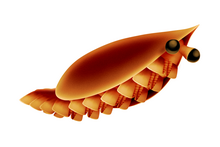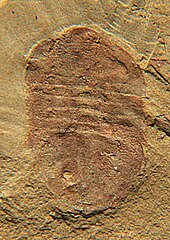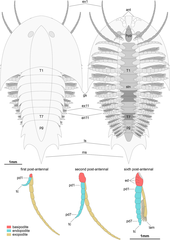Paleobiota of the Maotianshan Shales
This is a list of fossils found at Maotianshan Shales, whose most famous assemblage of organisms are referred to as the Chengjiang biota.[1]
The Maotianshan Shales are a series of Early Cambrian sedimentary deposits in the Chiungchussu Formation,[2] famous for their Konservat Lagerstätten, deposits known for the exceptional preservation of fossilized organisms or traces. The Maotianshan Shales form one of some forty Cambrian fossil locations worldwide exhibiting exquisite preservation of rarely preserved, non-mineralized soft tissue, comparable to the fossils of the Burgess Shale of British Columbia, Canada.
| Genus | Species | Material | Notes | Images |
|---|---|---|---|---|
|
|
A small ecdysozoan worm that was originally thought to have been a priapulid worm. |
 | |
|
|
An ecdysozoan worm considered close to the priapulids, it has a spiny proboscis, an elliptical theca on the posterior part of the trunk, and a caudal appendage. |
| Genus | Species | Material | Notes | Images |
|---|---|---|---|---|
|
A genus of palaeoscolecid worm. Fossils have been found with smaller worms seemingly attached to them. |
 | ||
|
||||
|
An extinct palaeoscolecid worm closely related to Cricocosmia. |
 | ||
|
A genus of palaeoscolecid worm |
|||
|
| Genus | Species | Material | Notes | Images |
|---|---|---|---|---|
|
An archaeopriapulid worm known from the biota. |
 | ||
|
A single specimen. |
A stem-group priapulid. |
||
|
A carnivorous priapulid-like worm that has been found living in the discarded shells of hyoliths. |
 | ||
|
An archaeopriapulid worm that resembles another worm, Selkirkia, from the Burgess shale |
 | ||
|
Two specimens |
 | ||
|
 | |||
|
A burrowing archaeopriapulid worm also known from the burgess shale, alongside the Fezouata Shale. |
 | ||
|
A genus of archaeopriapulid worm. |
 | ||
|
Fourteen specimens, five previously included in “Yunnanpriapulus” |
A priapulid worm thought to belong to the crown group. |
 |
| Genus | Species | Material | Notes | Images |
|---|---|---|---|---|
|
|
An unarmoured lobopodian, apparently closely related to Onychophora. The long, paired, cirriform structures at the end of the body could have been sensory, or perhaps represent viscera not externally present in life. |
 | |
|
A highly elongate armoured lobopodian, with saddle-shaped sclerites and a lightly sclerotized head. |
 | ||
|
A heavily armoured lobopodian. |
 | ||
|
|
A simple, unarmoured lobopodian. |
 | |
|
|
An enigmatic genus of lobopodian, potentially related to either the Luolishaniidae or to Tardigrada. Not always monophyletic. |
 | |
|
|
A large unarmoured lobopodian, commonly found in association with mass death-beds of legless worms and Eldonia. Thought to have been a scavenger. |
 |
| Genus | Species | Material | Notes | Images |
|---|---|---|---|---|
|
Around forty specimens |
Type genus of Luolishaniidae. The species Miraluolishania haikouensis is considered a juvenile synonym of Luolishania. |
 | |
|
Thirty specimens, one formerly assigned to “Xishania” |
Derived Luolishaniid lobopodian with five setiferous sieving appendages, and lacking any walking limbs. Sometimes discovered living in constructed tubes, buried into the sediment. |
 | |
|
Two specimens |
A hallucigeniid lobopodian with a bulbous sclerotized head and two pairs of small feeding appendages, borne on a short neck. |
 |
| Genus | Species | Material | Notes | Images |
|---|---|---|---|---|
|
|
A giant gilled lobopodian, closely related to Pambdelurion. Also present in the Xiaoshiba Biota. |
 |
Radiodonta are a group of highly successful panarthropods. The Chengjiang Fauna includes a large number of Radiodont species, primarily from the clade Amplectobeluidae. While hurdiids are poorly known from the formation and surrounding region, several specimens attributable to the family have been discovered, but remain unnamed. Some radiodonts from the Chengjiang defy easy classification, or are otherwise debated in their exact affinity.
| Genus | Species | Material | Notes | Images |
|---|---|---|---|---|
|
|
Previously described as "Anomalocaris" saron. |
 | |
| Innovatiocaris |
|
|
Previously assigned to the Anomalocaris genus, and one of the most completely known radiodonts. |  |
|
|
A giant radiodont combining features from different clades. |
 |
| Genus | Species | Material | Notes | Images |
|---|---|---|---|---|
|
|
A large Amplectobeluid radiodont with long tail furcae. The frontal appendages formed a distinctive claw-like shape. |
 | |
|
|
Small Amplectobeluid radiodont. Some specimens of this genus represent some of the smallest known radiodonts. |
 | |
|
|
Large Amplectobeluid radiodonts, with crushing gnathobases. The species R. consimilis may belong to Houcaris instead.[3] |
 |
| Genus | Species | Material | Notes | Images |
|---|---|---|---|---|
|
|
 | ||
|
|
A second species is included in the genus, Lenisicaris pennsylvanica, from the Kinzers Formation. |
 | |
|
|
An unusual radiodont seemingly transitional between anomalocaridids and amplectobeluids, with an oral cone similar to the former but gnathobase-like structures similar to the latter. |
 |
Hurdiids (peytoiids[3]) have historically been considered absent, or at least rare, from the Chengjiang Biota, an observation that researchers have found confusing given their regularity at other sites. In recent years, a number of fragmentary hurdiid fossils have been described, including 3 partial appendages belonging to a new species of Stanleycaris,[4] an isolated sclerite assigned to Cambroraster,[5] Zhenghecaris (the affinities of which, even its identity as a radiodont, remains questionable), and isolated lateral scelrites (also questionable).[6]
| Genus | Species | Material | Notes | Images |
|---|---|---|---|---|
|
|
A large nektobenthic hurdiid, first known from the Burgess Shale. Fossils of Cambroraster are also known from Mantou Formation of North China,[7] making this a very widespread genus. This genus was the first definitive peytoiid known from China. |
 | |
|
|
Large-sized arthropod carapace, originally described as bivalved arthropod close to Thylacocephala, later reinterpreted as hurdiid radiodont close to Cambroraster, its classification is still discussed. Some fossils, apparently the lateral scelrites of a radiodont, connected anteriorly by a "beak" and featuring two-pronged, wing-like processes posteriorly (similar to the lateral processes of Zhenghecaris's central head sclerite), have also been attributed to Zhenghecaris.[6] |
 |
| Genus | Species | Material | Notes | Images |
|---|---|---|---|---|
| Chuandianella |
|
|
An enigmatc bivalved arthropod originally considered close to Waptia. It was then discovered that it lacked mandibles and therefore does not belong to Hymenocarina, the Waptiidae family, and even the larger mandibulata clade. |  |
|
An enigmatic bivalved arthropod. |
|||
|
|
An enigmatic arthropod that has been tentatively classified as a possible radiodont, although a position closely related to Erratus as the most primitive deuteropod is more likely. |
 | |
|
Cyathocephalus |
|
|||
|
||||
|
A small arthropod that is currently "too poorly preserved to verify their identity as a valid taxa". |
|||
|
|
A bivalved arthropod currently placed as the most basal deuteropod, that shows the origins of lungs and legs in early arthropods. |
 | |
|
An arthropod that has been speculated to be an early crustacean. |
|||
|
A small bivalved arthropod that somewhat resembles ostracods, but also has large, upward facing appendages with spines. |
 | ||
|
||||
|
A basal nektonic arthropod that possessed a bivalved carapace, and large circular eyes, related to Surusicaris from the Burgess Shale. Also found in various other Cambrian aged sites. |
 | ||
|
A small, somewhat enigmatic arthropod known from the biota |
 | ||
|
||||
|
|
An early arthropod that may show the "missing link" between early stem-arthropods, and more advanced true arthropods. It possessed frontal appendages similar to radiodonts. |
 | |
|
||||
|
||||
|
A predatory arthropod that had spiked frontal appendages similar to those of the megacheirans, and was previously thought to have belonged to that grouping |
 | ||
|
||||
|
An arachnomorph arthropod of the group strabopida. Unlike the other members of strabopida, Parapaleomerus lacks dorsal eyes and only possesses ten trunk tergites. The telson has been described as trapezoidal in shape. |
 | ||
|
||||
|
A poorly known arthropod that, in 2013, was suggested to be a member of the family Kootenichelidae, alongside Kootenichela and Worthenella. |
|||
|
||||
|
||||
|
||||
|
||||
|
||||
|
A giant arthropod once misidentified as a peytoiid radiodont. |
|||
|
||||
|
||||
|
 | |||
|
| Genus | Species | Material | Notes | Images |
|---|---|---|---|---|
|
|
Also known in the Burgess Shale by B. pretiosa, B. yunnanensis is only known from isolated carapaces, although it is thought that this may be because in this species the carapace covered the entire body. It also has two morphotypes. |
 | |
|
A hymenocarine arthropod, also known from the Burgess Shale by C. perfecta, although some authors believe that both species should be separated into different genera. They were mainly benthic animals. |
 | ||
|
A hymenocarine arthropod. The species in the genus are primarily distinguished by the presence of a serrated edge on the front of the carapace of C. serrata. C. serrata is noted for the modification of an anterior pair of limbs into spined grasping appendages, indicating a predatory lifestyle. |
 | ||
|
A hymenocarine arthropod that had a bivalved carapace which covered about a third of its total body-length, and had up to six serrations on its forward edge. The head had a pair of large uniramous antennae, as well as a smaller pair of secondary antennae, and a pair of mandibles and maxillae. |
 | ||
|
A small euarthropod, and unlike other hymenocarines, it possibly had eyes directly on top of its carapace. It was most likely a nektobenthic animal. |
 | ||
|
A bivalved arthropod of the hymenocarina grouping. The species P. spatiosa is regarded as a filter feeder, using the setae on the endites of their limbs to filter out matter from the water column |
 | ||
|
A hymenocarine notable for fossils showing a bizarre chain of multiple individuals. Although the purpose for this behavior is unknown, it may have served a reproductive, migratory, or defensive purpose, with the authors of the describing paper of this genus considering migration as its most likely function. |
 | ||
| Tuzoia |
|
|
A large hymenocarine that possessed a semicircular bivalved carapace, and was one of the largest arthropods from the Cambrian |  |
| Jugatacaris | A. agillis |
|
A hymenocarine arthropod. The carapace of the animal was around 28 to 37 millimetres (1.1 to 1.5 in) in length, with a pronounced ridge at the top of the carapace separating the two valves, which formed a fin-like structure raised above the carapace. The head had a pair of stalked eyes, as well as a dumbbell shaped medial eye between them. The head also bore a pair of mandibles as well as at least one and possibly two pairs of antennules. |  |
| Xiazhuangocaris | X. chenggongensis |
|
A hymenocarine with no known head fossils. The material known show that the carapace had a pronounced pair of notches at its front, as well as a posterior notch at its rear. The body had at least 13 tergite-pleurite rings, which terminate in a pair of rounded caudal rami, which are fringed with setae. |  |
| Genus | Species | Material | Notes | Images | |
|---|---|---|---|---|---|
|
A Fuxianhuiid arthropod with numerous appendages. It is one of the most complete arthropods from the lower Cambrian. |
 | |||
|
A large arthropod named after Fuxian Lake. Some adult specimens are found closely associated with numerous juveniles, indicating a level of parental care. |
 | |||
|
A roughly 7 cm long fuxianhuiid, with which Shankouia is potentially synonymous through sexual dimorphism. |
| Genus | Species | Material | Notes | Images |
|---|---|---|---|---|
|
 |
| Genus | Species | Material | Notes | Images |
|---|---|---|---|---|
|
A small arthropod related to Leanchoilia, also known from the Burgess Shale. |
 | ||
|
One of the several species of Leanchoilia, it has known juvenile specimens and the labrum morphology known. |
 |
| Genus | Species | Material | Notes | Images |
|---|---|---|---|---|
|
 | |||
| Sklerolibyon | *S. maomima |  | ||
|
| |||
|
A jianfengiid once misidentified as a radiodont |
 |
| Genus | Species | Material | Notes | Images |
|---|---|---|---|---|
|
 |
Clade Gnathifera
[edit]| Genus | Species | Material | Notes | Images |
|---|---|---|---|---|
|
||||
|
 |
| Genus | Species | Material | Notes | Images |
|---|---|---|---|---|
|
||||
|
 | |||
|
 |
| Genus | Species | Material | Notes | Images |
|---|---|---|---|---|
|
 |
| Genus | Species | Material | Notes | Images |
|---|---|---|---|---|
|
 | |||
|
 |
| Genus | Species | Material | Notes | Images |
|---|---|---|---|---|
|
||||
|
||||
|
||||
|
| Genus | Species | Material | Notes | Images |
|---|---|---|---|---|
|
| Genus | Species | Material | Notes | Images |
|---|---|---|---|---|
|
 |
| Genus | Species | Material | Notes | Images |
|---|---|---|---|---|
|
| Genus | Species | Material | Notes | Images |
|---|---|---|---|---|
|
||||
|
 | |||
|
 | |||
|
||||
|
||||
|
| Genus | Species | Material | Notes | Images |
|---|---|---|---|---|
|
A chordate known from the Yunnan Province with potential relations to cephalochordates like lancelets. |
 | ||
|
An early craniate (an animal with a distinct notochord and head) of the Myllokunmingiida order. Some authors consider it potentially synonymous with the contemporary Myllokunmingia.[8] |
 | ||
|
A myllokunmingiid known for its wide body plan, sail-like fin on its dorsal plane, and a non-biomineralized skeleton. |
 | ||
|
Likely one of the earliest known tunicates, alongside Cheungkongella and possibly “Palaeoikopleuria”. |
 | ||
|
Another myllokunmingiid known for lacking a dorsal fin, and having a more slim body compared to its two contemporary relatives. |
 | ||
|
An early chordate thought to represent a transitional form between earlier chordates, and more derived craniates. |
 |
| Genus | Species | Material | Notes | Images |
|---|---|---|---|---|
|
Senior synonym of Cheungkongella ancestralis. |
 | ||
|
 | |||
|
Senior synonym of Eldonia eumorpha. |
 |
| Genus | Species | Material | Notes | Images |
|---|---|---|---|---|
|
||||
|
 |
Phylum Hemichordata
[edit]| Genus | Species | Material | Notes | Images |
|---|---|---|---|---|
|
||||
|
||||
|
Phylum Ctenophora
[edit]| Genus | Species | Material | Notes | Images |
|---|---|---|---|---|
|
 | |||
|
 | |||
| Stromatoveris |
|
|||
| Trigoides |
|
| Genus | Species | Material | Notes | Images |
|---|---|---|---|---|
|
||||
|
||||
|
||||
| Hazelia |
|
|||
|
||||
|
||||
| Paraleptomitella |
|
|||
|
||||
|
||||
| Sinfoflabrum |
|
 | ||
| Triticispongia |
|
| Genus | Species | Material | Notes | Images |
|---|---|---|---|---|
|
 | |||
|
||||
|
||||
|
 |
Enigmatic
[edit]| Genus | Species | Material | Notes | Images |
|---|---|---|---|---|
|
 | |||
|
||||
|
||||
|
||||
|
 | |||
|
||||
|
 | |||
|
 | |||
|
||||
|
||||
|
||||
|
||||
|
||||
|
Possible synonym of Nectocaris pteryx |
 | ||
|
||||
|
||||
|
||||
|
||||
|
Miscellaneous macroalgae
[edit]Macroalgae rank fourth in species-level diversity behind arthropods, priapulids, and sponges, and account for 71.5% of total abundance from the biota, particularly dominated by unattached (floating, planktonic, and drifting) species.[9]
| Genus | Species | Material | Notes | Images |
|---|---|---|---|---|
|
Sessile, attached to the substrate. | |||
|
The most common species of macroalgae present, accounting for 52% of all macroalgae fossils reported from the Chengjiang. | Unattached (planktonic, drifting, floating) | ||
|
Unattached (planktonic, drifting, floating) | |||
|
Sessile, attached to the substrate. | |||
|
Unattached (planktonic, drifting, floating) |  | ||
|
Sessile, attached to the substrate. | |||
|
Unattached (planktonic, drifting, floating) | |||
|
Sessile, attached to the substrate. | |||
|
Sessile, attached to the substrate. | |||
|
Unattached (planktonic, drifting, floating) |  | ||
|
Unattached (planktonic, drifting, floating) |  | ||
|
Unattached (planktonic, drifting, floating) |
References
[edit]- ^ "Chengjiang Maotianshan Shales". www.fossilmuseum.net. Archived from the original on 9 March 2021. Retrieved 10 September 2015.
- ^ Lipps, J. H.; Signor, P. W (1992). Origin and early evolution of the Metazoa. Springer. ISBN 978-0-306-44067-0.
- ^ a b McCall, Christian R. A. (September 2023). "A large pelagic lobopodian from the Cambrian Pioche Shale of Nevada". Journal of Paleontology. 97 (5): 1009–1024. Bibcode:2023JPal...97.1009M. doi:10.1017/jpa.2023.63. ISSN 0022-3360.
- ^ Wu, Yu; Pates, Stephen; Ma, Jiaxin; Lin, Weiliang; Wu, Yuheng; Zhang, Xingliang; Fu, Dongjing (1 November 2022). "Addressing the Chengjiang conundrum: A palaeoecological view on the rarity of hurdiid radiodonts in this most diverse early Cambrian Lagerstätte". Geoscience Frontiers. 13 (6): 101430. Bibcode:2022GeoFr..1301430W. doi:10.1016/j.gsf.2022.101430. ISSN 1674-9871.
- ^ Liu, Yu; Lerosey-Aubril, Rudy; Audo, Denis; Zhai, Dayou; Mai, Huijuan; Ortega-Hernández, Javier (July 2020). "Occurrence of the eudemersal radiodont Cambroraster in the early Cambrian Chengjiang Lagerstätte and the diversity of hurdiid ecomorphotypes". Geological Magazine. 157 (7): 1200–1206. Bibcode:2020GeoM..157.1200L. doi:10.1017/S0016756820000187. ISSN 0016-7568.
- ^ a b Zeng, Han; Zhao, Fangchen; Yin, Zongjun; Zhu, Maoyan (2 January 2018). "Morphology of diverse radiodontan head sclerites from the early Cambrian Chengjiang Lagerstätte, south-west China". Journal of Systematic Palaeontology. 16 (1): 1–37. Bibcode:2018JSPal..16....1Z. doi:10.1080/14772019.2016.1263685. ISSN 1477-2019.
- ^ Sun, Zhixin; Zeng, Han; Zhao, Fangchen (September 2020). "Occurrence of the hurdiid radiodont Cambroraster in the middle Cambrian (Wuliuan) Mantou Formation of North China". Journal of Paleontology. 94 (5): 881–886. Bibcode:2020JPal...94..881S. doi:10.1017/jpa.2020.21. ISSN 0022-3360.
- ^ Lerosey-Aubril, R.; Ortega-Hernández, J. (2024). "A long-headed Cambrian soft-bodied vertebrate from the American Great Basin region". Royal Society Open Science. 11 (7). 240350. Bibcode:2024RSOS...1140350L. doi:10.1098/rsos.240350. PMC 11267725. PMID 39050723.
- ^ Li, Gaorong; Wei, Fan; Guo, Jin; Cong, Peiyun (2024). "Macroalgae from the early Cambrian Chengjiang biota". Papers in Palaeontology. 10 (5): e1585. Bibcode:2024PPal...10E1585L. doi:10.1002/spp2.1585. ISSN 2056-2802.
































